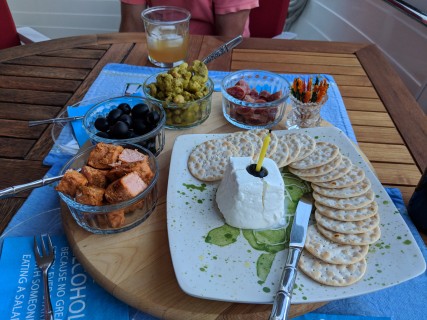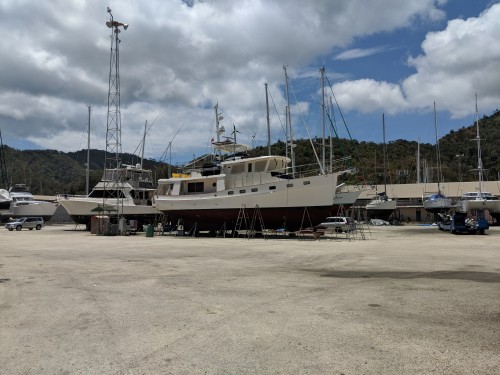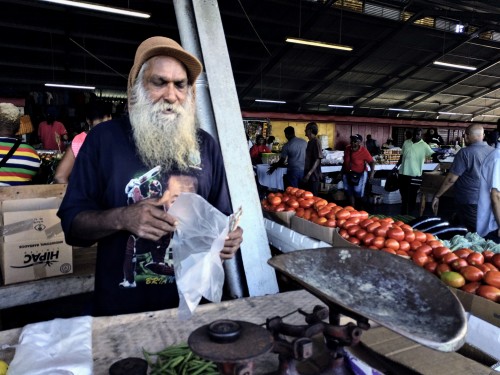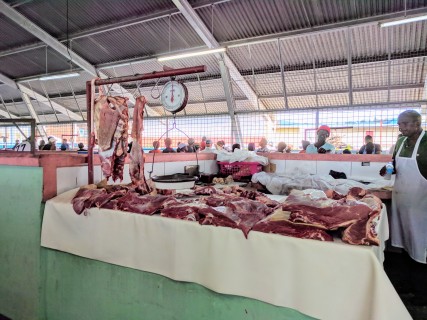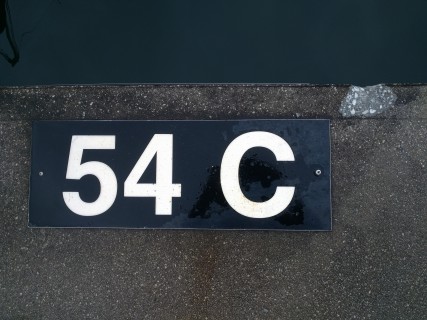Gooooooood Morning!
On Monday, we did the tourist thing. Mark had a dive trip planned with a local operator, so we hitched a ride in to Christiansted with him. We had a very tasty breakfast at “The Avocado Pit”, while we waited for Sweeny, who runs a local tour bus business. Our tour took us to St. George Botanical Gardens, a must-see, after which we traveled to Fredericksted. There, we toured the old Danish fort, and took lunch at “The Turtle Deli.” The sandwiches were HUGE. Suzanne and I shared one while gazing out over the water from our picnic table in the shade of Sea Grape trees. Sweeny rallied the troops, and it was off to the Cruzan Rum distillery, where we went on a guided tour, ending at their asmuchasyouwant tasting room. Compared to our Bacardi visit, we agreed that this tour was by far the better.
As Mark and Judy were leaving Tuesday morning, they asked us if we wanted to ride along. “Heck Yeah!” We spent the day driving around, exploring. After touring the restored Danish fort in Christiansted, we drove east to Udall Point, the scenic overlook on the easternmost end (and of the USA) of the island. On the way there, we visited the radiotelescope which is the east end of the V.L.B.A. (Very Long Baseline Array), a string of ten identical dishes extending from here to Mauna Kea in Hawaii. We had lunch on the north coast at “Off the Wall,” on the beach at Cane Bay. Mark loves getting off the beaten path, so we drove some pretty sketchy roads through the rain forest and along the coast, stopping for Sundowners at “Rainbow Beach Bar” outside Fredericksted.
Wednesday was a hangaroundthemarina day. We arranged for a car rental (no mean feat-most were taken), and contacted “St. Croix Dive Experience” to secure two spots on their Friday morning dive boat. Since we hadn’t been diving since the Bahamas a year ago, and we both had new regulators, we thought it’d be best to do a warm-up dive with a professional operator, for safety’s sake.
On Thursday morning, our rentacar was delivered at 09h00, and we were off. Our first destination was Salt River, where the National Park Service has a visitor’s center overlooking the water. Salt River was the site of Columbus’ 1493 return to NA with 17 ships. This time the natives were not as friendly. The view was tremendous, and the talk by the volunteer ranger was very informative. We also had a chance to check out Gold Coast Yachts, the boatbuilder where Larry (from Michigan) works. Heading to the west, we visited Estate Whim, an old sugar plantation which had been restored by the local Historical Society. Definitely worth the visit. The awesome sandwiches at the Turtle Deli in Fredericksted were calling, so we had lunch on the beach there. After our drivearound exploring the backroads of the island, we hit the Cruzan Rum distillery to replenish the ship’s stores. Mexican Train dominoes provided the evening entertainment.
We were on our way to Christiansted before 08h00, and were at the dock loading our dive gear on the boat by 08h15. We were fortunate to have the owner of the company, Michelle, as one of the crew. She’s logged over 10,000 dives around St. Croix, and is a local legend. Although the water was a bit stirred up from strong winds the previous couple of days, the visibility was still 100’ or so. Our new SCUBA gear worked well. Our old dive computers-not so much. Although we had fired them up the day before, neither wanted to turn on. Mine is 31 years old, and doesn’t owe me a nickel. Suzanne’s is only 5 years old, so we were a bit disappointed. No worries, the crew had a couple for us to use, and all was well. Although the reef wasn’t very healthy, we saw a fair bit of marine life, highlighted by several Green turtles, Reef sharks, a Spotted Eagle Ray, and a big Stingray. Of course, all of the smaller usual suspects were present as well. After a quick shower, and lunch at the “The New Deep End Bar and Grill”, it was time to reprovision. CostUless is the St. Croix version of Sam’s Club, and we found most of what we needed there. Their produce looked like it had just come off the boat, so we were happy campers. On the way home, we stopped at Seaside grocery for the couple of items that we were missing.
Our friends on dirt often ask us “What do you do all day?” Imagining, I’m sure, that we sit around drinking cute little umbrella drinks while lounging in our hammocks. Well, yesterday I screwed all day. I literally crawled from one end of the boat to the other, armed with nutdrivers and screwdrivers, tightening every fastener that I could find. Loose hose clamps may mean water on the wrong side of the hull, and loose electrical connections make for heat, corrosion, and possibly fire, none of which would be a good thing. By the time I crawled out of the engine room at 17h30, I looked like I had just gotten out of the shower, and had lost 3 pounds. Screwing all day takes a lot out of you. Suz spent the day doing “Admiral stuff”, paying bills, working on our taxes, and etc. In the evening, Chris (Captain from the Ocean Alexander) and Christina, his wife, picked us up and we all cruised into Christiansted for dinner at “Rumrunners Bar and Grill.” The seafood pasta special was delicious. St Croix is a beautiful, quiet island steeped in history and friendly people. Definitely worth a visit.
It’s Super Bowl Sunday. Today, we’ll get the Girl ready to leave tomorrow morning. The plan is to head out to Buck Island, a National Park marine preserve about 3 miles offshore. You must get a permit from the Park Service (which we did upon our arrival here in St. Croix) to anchor there. We’ll drop the hook on the lee side of the island there for a few nights and do some snorkeling/diving before heading to St. Bart’s (or St. Martin). Probably won’t have interweb for awhile, so…..
-Later









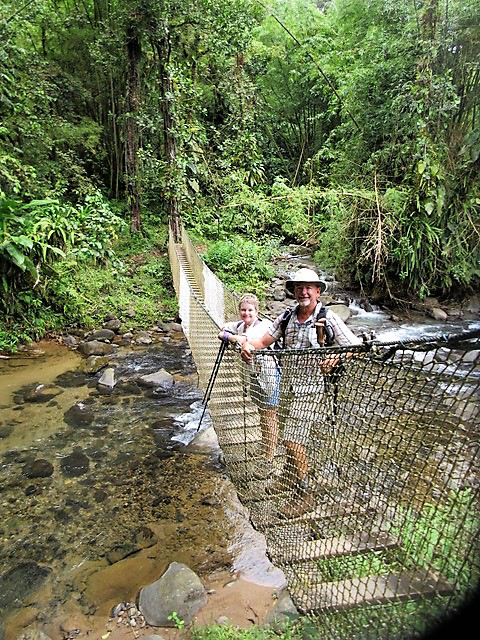
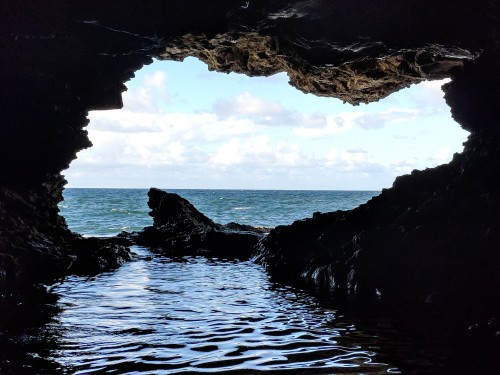
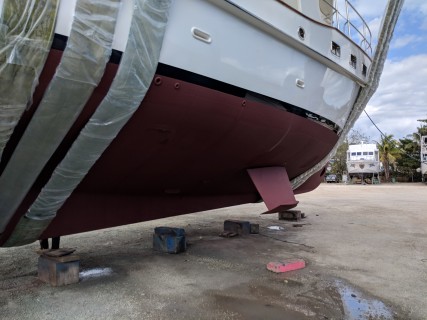
 John and Paulette, who had been there for two weeks aboard Seamantha were standing on the seawall waving when we arrived. Paulette, true to form, had remembered that it was my birthday and had us over for her (in)famous rhum punch and munchies. We went home early, fell into bed and slept like the dead.
John and Paulette, who had been there for two weeks aboard Seamantha were standing on the seawall waving when we arrived. Paulette, true to form, had remembered that it was my birthday and had us over for her (in)famous rhum punch and munchies. We went home early, fell into bed and slept like the dead.